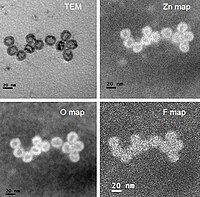
Photo from wikipedia
The low-temperature emission spectrum of CdSe colloidal nanoplatelets (NPLs) consists of two narrow lines. The high-energy line stems from the recombination of neutral excitons. The origin of the low-energy line… Click to show full abstract
The low-temperature emission spectrum of CdSe colloidal nanoplatelets (NPLs) consists of two narrow lines. The high-energy line stems from the recombination of neutral excitons. The origin of the low-energy line is currently debated. We experimentally study the spectral shift, emission dynamics, and spin polarization of both lines at low temperatures down to 1.5 K and in high magnetic fields up to 60 T, and show that the low energy line originates from the recombination of negatively charged excitons (trions). This assignment is confirmed by the NPL photocharging dynamics and associated variations in the spectrum. We show that the negatively charged excitons are considerably less sensitive to the presence of surface spins than the neutral excitons. The trion binding energy in 3-monolayer-thick NPLs is as large as 30 meV, which is four times larger than its value in two-dimensional limit of a conventional CdSe quantum well confined between semiconductor barriers. A considerable part of this enhancement is gained by the dielectric enhancement effect, that is due to the small dielectric constant of the environment surrounding the NPLs.
Journal Title: Nano letters
Year Published: 2020
Link to full text (if available)
Share on Social Media: Sign Up to like & get
recommendations!